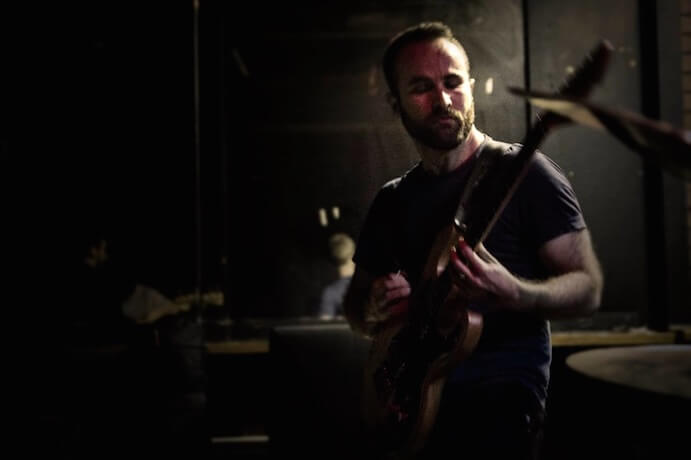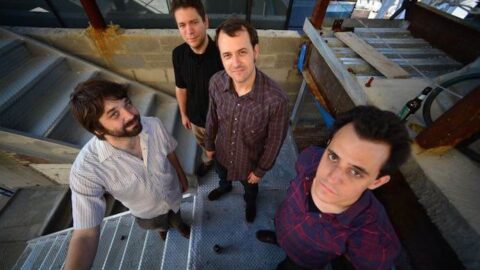On June 20, 2017, patrons of Brooklyn’s progressive-music proscenium, Roulette, were treated to a continuation of guitar wizard Brendon Randall-Myers’ ongoing artist residency. Entitled Dynamics of Vanishing Bodies—and described as a follow-up to February’s sometimes haunting sometimes hilarious and consistently mesmerizing Invisible Anatomy—the evening’s program featured a series of improvisations and premieres composed by Randall-Myers. Joined by a cast of prominent New York City musicians including Eliza Bagg, Miki Sawada, Jonny Allen, Josh Henderson, Maria Hadge, Doug Moore and DITHER (James Moore, Josh Lopes, Brett Parnell and Randall-Myers), the evening offered a relatively informal glimpse into Randall-Myers’ diverse and colorful oeuvre; minus the theatricality of Invisible Anatomy, plus an equally compelling, more personal focus on Randall-Myers’ very distinct and most excellent visions in sound.
Randall-Myers started the show performing a delicate work for solo steel string guitar called Grace and Decay, which was commissioned to serve as the 2017 audition piece for Yale School of Music’s guitar studio by department head Ben Verdery. The work is a crystalline halo of harmonics that orbit fuller tones produced by open strings and idiomatic, guitaristic harmonies. Randall-Myers performed his work with fluidity and apparent ease, though it was easy to grow anxious for all those hopeful Yale guitar candidates, whose fate may be governed by the task of learning this challenging piece. In the final few minutes of Grace and Decay, Bagg, Sawada, Allen, Henderson, and Hadge emerged quietly and took their places on the stage, surrounding Randall-Myers as he finished the piece. It was a dramatic moment that implied a seamless attacca into the next group of compositions, but was interrupted by a brief volley of comments. Ironically, Randall-Myers took that moment to express his distaste for talking at length (and in front of people), having done so out of a presumed obligation and all the while imploring those in attendance to allow the music to speak for itself.

Three standalone songs followed featuring texts written by the composer and sung by Bagg with the above mentioned roster of talented players. Everyday Objects challenges the question of inherent and projected meaning on the objects with which we surround ourselves; can we infuse so-called meaning into our belongings, and does our perception of those objects change within that context? Weight (world premiere) explores the fear of absence, touching upon themes in our current political climate closely alluding to the challenges faced by immigrants. New You, in the composer’s words, is a song about “cell death,” and examines the potential dilemma posed by the human body’s cyclical replacement of its material with all new cells every ten years or so. In summary, when that happens, are you still you? While Bagg sung beautifully, it felt as though there was room for a broader exploration of her vocal capability. Some interesting extended techniques offered glimpses of new dimensions (Everyday Objects was largely sung into the body of the amplified acoustic guitar, which served as microphone and sympathetic resonator), but on the whole, the vocal line seemed anchored in a monochromatic, pop idiom that did not allow her to stand out.
After returning from a brief intermission, Randall-Myers was joined by Doug Moore, vocalist and guitarist of New York based experimental metal unit Pyrrhon, for a dyad of improvisations featuring expressive avant-vocals and electronic processing. Perhaps a bit too brief, the pieces that emerged maintained a kind of structured spontaneity that remained fresh throughout.
The evening’s namesake and main event was a five movement work for electric guitar quartet called Dynamics of Vanishing Bodies, brought to life by DITHER. According to Merriam-Webster, dither may be defined as: (noun) “a highly nervous, excited, or agitated state” and (verb) “to act nervously or indecisively.” DITHER, New York’s genre-defiant electric guitar quartet, channels many of these elements into their music-making, albeit redefining their eponym in much the same way they redefine the expectations and listening experience many may bear when approaching the electric guitar.

Throughout the angular, spectral strata of the work, Randall-Myers clearly showed that while excitement and agitation (and sometimes a little nervous energy) may add a sparkling lustre to his artistic voice, indecision plays no role in his output; he knows exactly what he is doing and manages to push DITHER toward another state of being, transcendent of the name and beyond the implication of their instruments. Of particular note was the fourth movement, “trem chorale/harmonic melody,” which echoed devices from Grace and Decay in its exploitation of natural harmonics. As the piece reached a steady momentum, it channeled the kinetic character of Tuvan throat singing and other folkish traditions that utilize the special quality of harmonic tones.
Brendon Randall-Myers is a great talent, and consistently surrounds himself with great musicians. Following the conclusion of his successful residency at Roulette, it is exciting to anticipate what may be coming next.
























